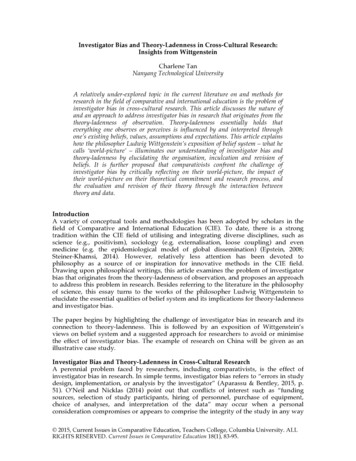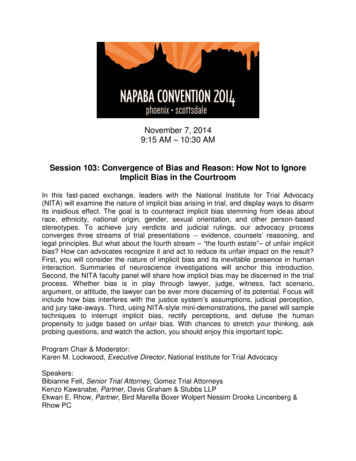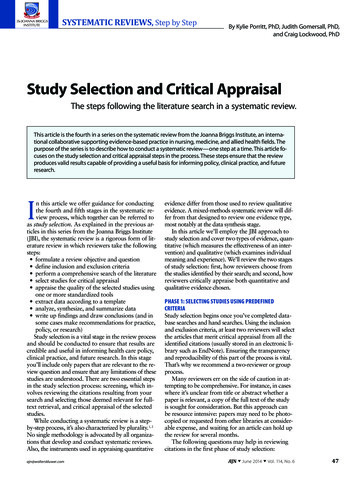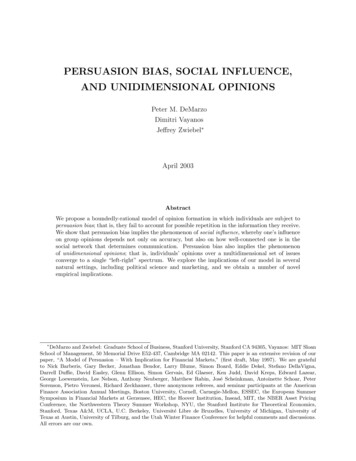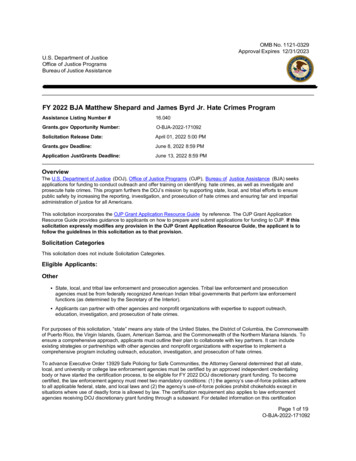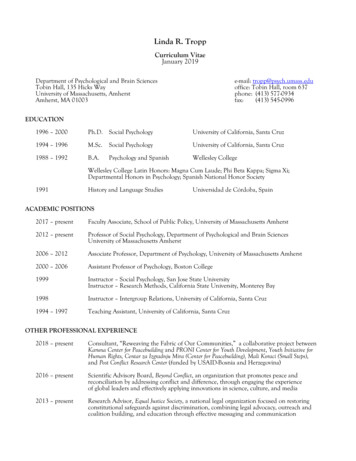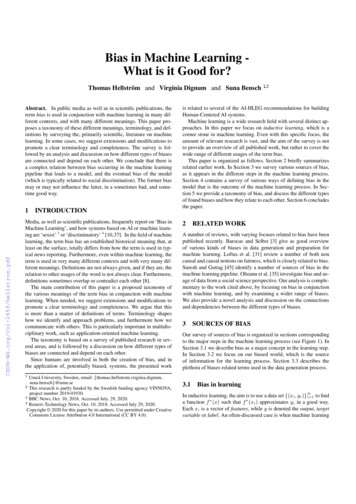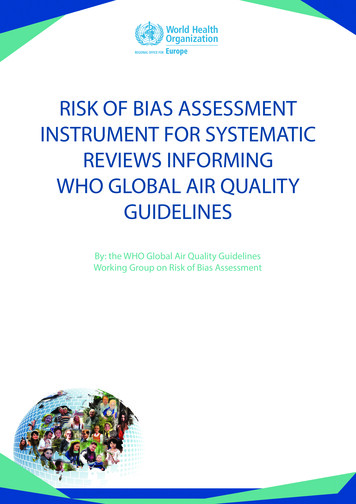
Transcription
Correcting inter-device bias of horizontal white-to-white and sulcus-to-sulcus measuresused for implantable collamer lens sizingIvo Guber, MD1, Ciara Bergin, PhD1, Sylvie Perritaz, Optom1, François Majo, MD, PhD11Department of ophthalmology, University of Lausanne, Fondation Asile des aveugles, JulesGonin Eye Hospital, Lausanne, SwitzerlandKey words:ICL; sulcus-to-sulcus; white-to-white; corneal diameter; UBM; Pentacam, HiScan;Biograph; Lenstar; Phakic Lens; vaulting; nomogram; ICL sizing.Short title:Improving implantable collamer lens sizingCorresponding author:François Majo, MD, PhDDepartment of ophthalmology, University of LausanneFondation Asile des aveugles, Jules-Gonin Eye Hospital,Cornea and Refractive Surgery Unit, Anterior Pole.Avenue de France 15, 1000 Lausanne 7, Vaud, SwitzerlandPhone: 41 (0) 21 626 81 11; Fax: 41 (0) 21 626 88 89; E-mail: fmajo@bluewin.ch1
ABSTRACTPURPOSE: To assess the agreement and repeatability of horizontal white-to-white (WTW) andhorizontal sulcus-to-sulcus (STS) diameter measurements and use this data in combination withavailable literature to correct for inter-device bias in pre-operative implantable collamer lens(ICL) size selection.DESIGN: Inter-instrument reliability and bias assessment study.METHODS: A total of 107 eyes from 56 patients assessed for ICL implantation at ourinstitution were included in the study. This was a consecutive series of all patients with suitableavailable data. The agreement and bias between WTW (measured with the Pentacam andBioGraph devices) and STS (measured with the HiScan device) were estimated.RESULTS: The mean spherical equivalent was -8.93D 5.69D. The BioGraph measures ofWTW were wider than those taken with the Pentacam (bias 0.26 mm, p 0.01), and bothhorizontal WTW measures were wider than the horizontal STS measures (bias 0.91 mm,p 0.01). The repeatability (Sr) of STS measured with the HiScan was 0.39 mm, which wassignificantly reduced (Sr 0.15 mm) when the average of two measures were used. Agreementbetween the horizontal WTW measures and horizontal STS estimates when bias was accountedfor was г 0.54 with the Pentacam and г 0.64 with the BioGraph.CONCLUSIONS: Large inter-device bias was observed for WTW and STS measures. STSmeasures demonstrated poor repeatability, but the average of repeated measures significantlyimproved repeatability. In order to conform to the Federal Drug Administration’s acceptedguidelines for ICL sizing clinicians should be aware of and account for the inconsistenciesbetween devices.2
INTRODUCTIONThe number of refractive surgery cases continuously increases; this is in line with thepatients’ expectation to achieve a perfect visual outcome, which demands highly accurate preoperative measures. A primary example of this is the implantable collamer lens (ICL; StaarSurgical, Monrovia, California, USA), which is a posterior chamber type phakic intraocular lensdesigned to be implanted in the ciliary sulcus. The FDA approved method of ICL sizedetermination is the conventional STAAR sizing nomogram that indicates the size using twoocular parameters: horizontal white-to-white (WTW distance from limbus to limbus/cornealdiameter) and anterior chamber depth (ACD).1 This method of determining the ICL size reliespredominately on the horizontal WTW measurement; which relies on the assumption that thereis a correlation between the white-to-white distances and the sulcus iridociliaris.2, 3An incorrect ICL-size will result in a suboptimal vaulting (distance between the anteriorlens surface and the ICL), which has been associated with number of visually significantpostoperative complications.4-12 Despite efforts to improve predictability of vault following ICLimplantation, it remains poor; the reasons for this are multiple.5, 13-23 High-frequency ultrasoundbiomicroscopy (UBM) with a wide scanning field has enabled direct measurement of horizontalsulcus-to-sulcus (STS) diameter. Poor correspondence (г 0.50) between the horizontal WTWand STS measure has since been reported, however the width of the limits of agreement (LoA)reported between horizontal WTW and STS measures is similar to repeatability limits of STSestimates. UBM devices have relatively low precision in STS estimates (coefficient of variation(CoV): Artemis NA; HiScan 0.9-2.7%16, 24; VuMax 5%25) as compared to horizontal WTWmeasures of Scheimpflug imaging or partial low-coherence inferometry (CoV: Orbscan 0.7%1%24; Galilei Sirius 0.5%26, 27; IOLMaster 2%28; Lenstar 0.2%23). For example, Yokoyama et al.have reported the within subject repeatability (Sw) of the Vumax UBM device to be approximately0.53mm (confidence interval (CI) of repeatability -1.1mm, 1.5mm).25 Afterwards Biermann et al.reported a “poor” level of agreement between the STS as measured with Vumax and horizontalWTW measured with Orbscan and IOLMaster, with a LoA of approximately (-0.7mm,-0.1mm)and (-0.4mm, 0.6mm) respectively (figure 5C pg. 1690), but since the inter-device agreement(between Vumax and Orbscan/IOLMaster) is better than intra-device precision (Vumax withitself), a conclusion of “poor” agreement is unsupported.18 In another article on UBM Artemisdevice, the CoV for STS measures was estimated as 0.4%, referencing a study on metallic bolt(not an eye), before reporting the “poor” agreement between the Artemis UBM and the Orbscan.2Considering the higher axial resolution than lateral resolution with UBM devices (50MHz probe:axial resolution 30-40µm and lateral resolution 50-60µm) and since central corneal thickness is amore clearly defined anatomical structure with less to inhibit clear imaging, it is reasonable thatrepeatability of central corneal thickness would be at least as good as STS. Therefore since therepeatability of the Artemis in central corneal thickness has since been established 2%, it seemsreasonable to propose the CoV of STS measures would be at least as wide as that of the CCT,which would translate to LoA in STS of 0.25mm. This would explain up to 50% of thedisagreement observed between STS (Artemis) and horizontal WTW (Orbscan) measures.2, 29 Inshort, different levels of measurement noise/calibration between measurement devices confoundcomparison.The following study examines three index measures, namely the STS diameter determinedwith ultrasound biomicroscopy (HiScan ), and the horizontal WTW distance measured with twodifferent devices (Pentacam and BioGraph ). The repeatability of each and the agreementbetween these index measures was assessed and in a large number of myopic and hyperopicpatients undergoing ICL-implantation. The BioGraph and HiScan devices were selected based onthe high level of precision accorded to each.23-25, 29-32 Our ultimate aim was to combine theseresults with those available in the literature and to provide an inter-device conversion table in3
order to better comply with the STAAR nomogram for ICL sizing.4
METHODSThis study conformed to the declaration of Helsinki and was approved retrospectively bythe cantonal ethic committee of Vaud (Authorization no. 035.0003-48).PatientsAll patients came with the desire for refractive surgery to a specialized consultation of theunit for cornea and refractive surgery at the Jules-Gonin Eye Hospital, Lausanne.MethodsThis is inter-instrument reliability and bias assessment using retrospective data, from areview of the ICL database of all consecutive patients, who had undergone pre-operative ICLassessment, between January 2000 and June 2014. In total 210 eyes of 107 patients werereviewed; of which 125 eyes of 65 patients had Pentacam measures available, 124 eyes of 64patients had BioGraph measures available, and 116 eyes of 59 patients had UBM available, 107eyes of 56 patients had all three measures available. There were no further inclusion or exclusioncriteria applied to the study cohort.All patients were measured with Pentacam HR and BioGraph as part of preoperativeevaluation for refractive surgery. If the patients were considered to be suitable candidates for ICLimplantation, a UBM measure of the ciliary sulcus was additionally performed. Prior to themeasurement one eyedrop of pilocarpin nitrate 2% (Bausch and Lomb, Surrey, UK) was instilledin order to achieve the best possible alignment of the UBM handpiece with the horizontal andvertical STS. All measurements were carried out by the same experienced optometrist (SP). Measurements:Index test 1) Pentacam HR (Oculus; Optikgeräte GmbH, Wetzlar, Germany softwareversion 1.20r02). Corneal tomography measurements in the 25-picture mode, scans were taken inautomatic release mode. If the system considered the measurement to be unreliable, themeasurement was repeated. Only measurements with a quality factor (Q) “OK”, as displayed bythe system, were used for analysis. Testing was conducted with the patient’s natural pupils undermesopic conditions. The horizontal WTW was determined manually on the Scheimpflug imageno. 17/25, as it represents the horizontal axe (183 degree; (Figure 1, top panel)). The caliperfunction available within the device was used to measure the distance from the anterior corneoscleral transition point from one side to the other (Figure 1, top panel). Two images taken of thesame eye from pre-operative follow-up visits were assessed by a single observer to estimate therepeatability of this measure.Index test 2) The ALLEGRO BioGraph (Wavelight AG) /BioGraph LS 900 (HaagStreit AG) is a multifunctional device which is used in preoperative patient evaluation beforecataract surgery and other procedures of refractive surgery. It is based on optical low coherenceinterferometry (OLCI) which captures 16 images in sequence. Along with standard biometrymeasures this device additionally provides a measurement of pupil diameter and visual axis, andhorizontal WTW diameter (Figure 1, center panel).Index test 3) A high-frequency B-scan diagnostic ultrasound biomicroscopy imagingsystem (Optikon HiScan, Optikon 2000 SpA, Rome, Italy) was employed in the present study.The system can capture the entire anterior segment in a single scan (Figure 1 bottom panel). Aprobe with a 35 MHz transducer was used for STS measurement. The axial and lateral resolution5
is 70 µm in the anterior segment with a penetration of 7-8 mm. The calliper function availablewithin the device was used to measure the distance of the horizontal ciliary sulcus from one sideto the other (Figure 1, bottom panel). The repeatability of STS measurements has been previouslyevaluated, and the coefficient of variation was 2.7%.26 To reduce measurement error 4-6 UBMimages where taken and the average STS measure was reported (0.9% as estimated by Oh et al.16).A single, experienced examiner (SP) carried out all UBM measurements. Statistical analysisData were exported and imported into R version 2.15.120 for analysis. Parameters used inanalysis were age, spherical equivalence (SE), axial length (AL), intraocular pressure (IOP),anterior chamber depth (ACD), WTW as measured with the Pentacam and the BioGraph andSTS as measured with the HiScan. Data were split into three subgroups for 3 parameters for subanalysis: ACD; shallow 3.2mm, medium 3.2mm-3.4mm and deep 3.4mm as previouslyreported by Gao et al.3 AL: moderate 25.0mm, long 25.0-27.0 and very long 27; SE: Hyperopiato moderate myopia up to -6D, high myopia -6 to -10D and very high myopia stronger than 10D. For UBM measures between 4 and 6 measures were taken, and the average of the full set ofmeasures was using in the agreement analysis. As per the British Standards Institute and theInternational Organization for Standardization, repeatability (Sr) (the within-subject SD forrepeated measures with the same observer) was derived using a one-way analysis of variance(ANOVA). For the HiScan device the STS estimate was the outcome and image number (1-6),patient (1-54) and eye (right/left) were covariates. For the Pentacam device, the horizontal WTWestimate was the outcome and image number (1-2), patient (1-48) and eye (right/left) werecovariates.6
RESULTSOne-hundred and seven eyes of 56 patients were analyzed. Mean spherical equivalent was-8.9D SD 5.67D, mean axial length was 26.67mm, SD 2.44mm and mean ACD was 3.17mm,SD 0.25mm. The baseline characteristics of these eyes are given in Table 1. A summary hasbeen given based on spherical equivalence (SE), where those with SE of -6D, those with SE 6D to -10D and very high myopes ( -10D) are compared. Furthermore, those eyes withastigmatism have been characterized (Table 1). Notably the horizontal WTW measures takenwith the BioGraph were significantly wider than those taken with the Pentacam (bias: 0.26mm,p 0.01) and the STS measures (bias: 1.17mm, p 0.01), also the horizontal WTW measures takenwith the Pentacam were significantly wider than the STS (bias: 0.91mm, p 0.01). Therelationship between horizontal WTW/ACD and horizontal WTW/axial length has been given inFigure 2. Here the horizontal WTW (Pentacam and BioGraph) and STS (UBM) measures weresignificantly smaller in eyes with shallow ACD ( 3.2mm) than in eyes with medium (3.2-3.4mm)or deep ACD (with the exception of horizontal WTW measures using the Pentacam in eyes withdeep and shallow ACD). There were no significant differences observed in the horizontal WTWmeasures of eyes in terms of axial length, however there were significant differences observed inthe STS measures of moderate versus long or very long eyes (Figure 2). Vertical and horizontalSTS diameters were highly correlated (p 0.001), however vertical STS was significantly largerthan horizontal STS by approximately 0.4mm, 4% of eyes had the inverse.Repeatability of ultrasound biomicroscopy measures:The HiScan UBM measures were less repeatable than expected with a Sr of 0.39mmbetween any two images and a 95% CI of 0.76 (shown with dotted horizontal line in Figure 3).Repeatability index improved to Sr of 0.15mm when the average of two measures was used (solidhorizontal line Figure 3); therefore, it is safe to assume that the repeatability is less than 0.15mmwhen the average of 4 or more images was used. Similar repeatability was observed betweensingle measures of vertical STS (Sr 0.26mm).Repeatability of horizontal white to white in Pentacam measures:Two images with image quality rated as “OK” within the device software were availableon 89 eyes of 48 study patients. The manual method for horizontal WTW assessment showedgood repeatability, with Sr 0.13mm and a CoV of 1%.Agreement between devices:The agreement between the devices was examined using Bland Altman plots (Figure 4),limits of agreement and Pearson correlation coefficients. The horizontal WTW measures as takenwith the Pentacam and the BioGraph showed good agreement (г 0.73) with some systematicbias (-0.26mm) and relatively tight limits of agreement (95% CI -0.93, 0.41). Comparing thehorizontal WTW of the Pentacam with the STS showed moderate agreement (г 0.54) with alarge systematic bias (0.91mm) with wide limits of agreement (95% CI -0.15, 1.97). Comparingthe horizontal WTW of the BioGraph with the STS showed moderate agreement (г 0.64) with alarger systematic bias (1.17mm) with wide limits of agreement (95% CI 0.26, 2.07). Theagreement between the ACD measures was better between BioGraph and Pentacam thanbetween these two devices and UBM (г 0.99 vs г 0.88/0.87).The relationship between systematic error and noise was examined with respect to SE,ACD and AL, the analysis is given in Table 2 using analysis of variance and accounting for pairsof eyes. On comparing the horizontal WTW measures of the Pentacam and BioGraph we see7
that the bias was significantly less in eyes with deep ACD than shallow (p 0.02). The agreementwas best between horizontal WTW and HCS estimates in eyes with average anterior chamberdepth (BioGraph vs UBM Pearson г 0.74).In Table 3 we provide a device conversion table to be used with the STAAR nomogram(or any replacement ICL sizing methodology) established from results of this study and theavailable literature (PubMed search with the keywords: corneal diameter, white-to-white,horizontal ciliary sulcus diameter, repeatability, precision, agreement, Pentacam, IOLMaster,Scheimpflug, Topography, UBM, ultrasound biomicroscopy, Orbscan, Vumax, Galilei, Lenstar,Biograph, Artemis, Hiscan).8
DISCUSSIONThis study provides information on the inter-device bias with measuring STS andhorizontal WTW. This is important as with the current STAAR nomogram for calculation of theICL size, a larger ICL size is proposed every 0.4mm of increasing horizontal WTW distance.1Therefore with the observed bias, large errors in sizing are possible due to differences betweeninstruments. For example the LoA between the Pentacam and BioGraph estimates of horizontalWTW (bias of -0.26mm SD 0.34) observed here, were similar to that previously reportedbetween Lenstar and Scheimpflug device.30, 32, 33 This equates to the Pentacam indicating an ICLsize one increment smaller than that by the BioGraph in approximately 35% of cases. Matters areconsiderably worse between STS vs horizontal WTW with a very large variance and systematicerror (bias of up to 1.2mm) between measures, indicating that rarely ( 10% of cases) would thesame ICL size be chosen. In this article the STS estimates were considerably narrower than thehorizontal WTW estimates (absolute bias: 0.9mm). These results agree with some estimates ofbias between horizontal WTW and STS estimates previously reported (bias -0.9mm),19 but arecompletely contradictory of others (bias: 0.9mm; bias: 0.5mm; bias: 0.4mm).2, 18, 24 This shows thatthere is very poor agreement between UBM devices in STS estimates (bias up to 1.2mm, 3 ICLsizes), highlighting the need for a conversion table between devices.Table 3 is of particular relevance as several authors have already suggested newnonograms for use with STS estimates.21, 23, 34, 35 A summary of available literature (to the best ofour knowledge, based on a PubMed search) on agreement between horizontal WTW and STS,showed that the Orbscan device was included in the largest proportion of articles, followed byreports including the IOLMaster. Therefore, the conversion table below gives the estimated biascorrection necessary when moving from the Orbscan to each of the other devices. To validatethis conversion table, a second table summarizing the conversion of IOLMaster to three differentdevices was included (Table 4). Importantly, Table 4 used non-overlapping literature, using Table3 and 4 a conversion loop of Orbscan to each of these three different devices, then toIOLMaster was created to demonstrate that the result is compatible with direct conversion(Orbscan to IOLMaster, Table 3). Here it was observed that the difference between theconversion loop and the direct conversion was 0.1mm, this indicates that the conversion tableperforms well. As more literature becomes available it can be compiled within this table tostrengthen it. We suggest that the surgeon specify the device used such that the manufacturermay account for the respective systematic bias via this conversion table when calculating the ICLsize.In our study the relationship between horizontal WTW and STS was good, especially inhighly myopic eyes (r 0.69) or eyes with medium (3.2mm-3.4mm) ACD (r 0.74). A full literaturesearch was completed on PubMed with the keywords as previously described. In this study thecorrelation between the two horizontal WTW measures was marginally higher than thecorrelation with STS, comparing the results of these studies; we observed very similar results asreported between horizontal WTW measures with optical low coherence reflectance biometryand scanning slit lamp imaging devices.24, 30, 36 Several authors have reported poor correlationbetween horizontal WTW and STS, however some important considerations were observed onreviewing this literature: Fea et al. used magnetic resonance imaging which cannot produce clearimages of the posterior chamber structures.15 Werner et al. measured the horizontal sulcusdiameter with digital calipers after dissection of cadaver eyes.14 Pop et al. used analog ultrasoundmicroscopy to measure STS, where the lateral scan width is insufficient to image sulcus diametersin 1 scan sweep.13 On the other hand Kawamorita et al. examined the agreement of the HiScanand Orbscan devices, and reported a similar correlation between STS and horizontal WTW asreported here.24 The repeatability of the UBM in our study was worse than reported in the9
literature; however, using the average of several measures significantly reduced the LoA, makingthese compatible to limits of repeatability reported with Scheimpflug methods.ACD measures taken with the BioGraph or the Pentacam correlate very well with oneanother with near perfect agreement, comparatively these measures do not correlate well with theACD estimate taken with the HiScan. Gao et al. previously reported a difference in thecorrelation between STS and horizontal WTW in shallow and deep eyes.3 Caution should betaken when used the ACD measures from the HiScan device.The correct distance from the anterior capsule of the crystalline lens to the posteriorsurface of the ICL or vault is an important consideration. In general, an acceptable vault height isbetween 250 µm and 1000 µm.5 In the preoperative evaluation of patients potentially suitable forICL implantation it is very important to highlight those patients who are at high risk of impropersizing of the ICL and consequently incorrect ICL vaulting. Apart from device relatedmeasurement error, the limitation of ICL sizes is problematic, currently only 500 m incrementsare available and the range of the ideal vaulting is relatively narrow by comparison. Lee et al. havedemonstrated that there is a relationship between the achieved vault and difference between thehorizontal WTW/STS measures and ICL sizes.22 If the ICL implant was available in smallerincrements this would facilitate the weakening of this relationship as the difference between thehorizontal WTW/STS and ICL size choice could be decreased.In conclusion the relationship between the horizontal ciliary sulcus diameter and whiteto-white distance is good especially in eyes with average ACD or high myopia. Care should betaken with the STS estimate for ICL sizing considering the relatively poor repeatability withUBM; however repeatability can be significantly improved when the average of repeatedmeasures is used. Furthermore there is large systemic bias between devices in estimates ofhorizontal WTW (e.g. BioGraph vs Pentacam) and between estimates of horizontal WTW andSTS (e.g. Pentacam vs HiScan) and between estimates of STS (Artemis vs HiScan). The large biasreported here, had been observed at our clinic and until this point was subjectively adjusted for.In this article we have attempted to estimate an appropriate error correction for all currentlyreported devices with the inclusion of a conversion table to be used in conjugation with theSTAAR nomogram for ICL sizing.10
ACKNOWLEDGMENTS/DISCLOSUREa. Funding/Support: noneb. Financial Disclosures: "No financial disclosures."c. Other Acknowledgments: none11
REFERENCES1.AG SS. Visian ICL (Implantable Collamer Lens) For Myopia. Visian ICL ProductInformation, 2005. Available at: http://www.accessdata.fda.gov/cdrh docs/pdf3/P030016c.pdf.Accessed August 24 2015.2.Reinstein DZ, Archer TJ, Silverman RH, Rondeau MJ, Coleman DJ. Correlation ofanterior chamber angle and ciliary sulcus diameters with white-to-white corneal diameter in highmyopes using Artemis VHF digital ultrasound. J Refract Surg 2009;25:185-194.3.Gao J, Liao R-F, Li N. Ciliary sulcus diameters at different anterior chamber depths inhighly myopic eyes. J Cataract Refract Surg 2013;39:1011-1016.4.Guber I, Chokri L, Majo F. [Preoperative sizing of the TICL (Toric Implantable CollamerLens): the largest was too small!]. Klin Monbl Augenheilkd 2012;229:457-458.5.Gonvers M, Bornet C, Othenin-Girard P. Implantable contact lens for moderate to highmyopia: relationship of vaulting to cataract formation. J Cataract Refract Surg 2003;29:918-924.6.Trindade F, Pereira F. Cataract formation after posterior chamber phakic intraocular lensimplantation. J Cataract Refract Surg 1998;24:1661-1663.7.Fink AM, Gore C, Rosen E. Cataract development after implantation of the Staarcollamer posterior chamber phakic lens. J Cataract Refract Surg 1999;25:278-282.8.Chung T-Y, Park SC, Lee MO, Ahn K, Chung E-S. Changes in iridocorneal anglestructure and trabecular pigmentation with STAAR implantable collamer lens during 2 years. JRefract Surg 2009;25:251-258.9.Rosen E, Gore C. Staar collamer posterior chamber phakic intraocular lens to correctmyopia and hyperopia. J Cataract Refract Surg 1998;24:596-606.10.Khalifa YM, Goldsmith J, Moshirfar M. Bilateral explantation of Visian ImplantableCollamer Lenses secondary to bilateral acute angle closure resulting from a non-pupillary blockmechanism. J Refract Surg 2010;26:991-994.11.Schmidinger G, Lackner B, Pieh S, Skorpik C. Long-term changes in posterior chamberphakic intraocular collamer lens vaulting in myopic patients. Ophthalmology 2010;117:1506-1511.12.Igarashi A, Shimizu K, Kamiya K. Eight-year follow-up of posterior chamber phakicintraocular lens implantation for moderate to high myopia. Am J Ophthalmol 2014;157:532-539.13.Pop M, Payette Y, Mansour M. Predicting sulcus size using ocular measurements. JCataract Refract Surg 2001;27:1033-1038.14.Werner L, Izak AM, Pandey SK, Apple DJ, Trivedi RH, Schmidbauer JM. Correlationbetween different measurements within the eye relative to phakic intraocular lens implantation. JCataract Refract Surg 2004;30:1982-1988.15.Fea AM, Annetta F, Cirillo S, et al. Magnetic resonance imaging and Orbscan assessmentof the anterior chamber. J Cataract Refract Surg 2005;31:1713-1718.12
16.Oh J, Shin H-H, Kim J-H, Kim H-M, Song J-S. Direct measurement of the ciliary sulcusdiameter by 35-Megahertz ultrasound biomicroscopy. Ophthalmology 2007;114:1685-1688.17.Kim K-H, Shin H-H, Kim H-M, Song J-S. Correlation between ciliary sulcus diametermeasured by 35 MHz ultrasound biomicroscopy and other ocular measurements. J Cataract RefractSurg 2008;34:632-637.18.Biermann J, Bredow L, Boehringer D, Reinhard T. Evaluation of ciliary sulcus diameterusing ultrasound biomicroscopy in emmetropic eyes and myopic eyes. J Cataract Refract Surg2011;37:1686-1693.19.Petermeier K, Suesskind D, Altpeter E, et al. Sulcus anatomy and diameter inpseudophakic eyes and correlation with biometric data: Evaluation with a 50 MHz ultrasoundbiomicroscope. J Cataract Refract Surg 2012;38:986-991.20.Choi KH, Chung SE, Chung TY, Chung ES. Ultrasound biomicroscopy for determiningVisian implantable contact lens length in phakic IOL implantation. J Refract Surg 2007;23:362-367.21.Kojima T, Yokoyama S, Ito M, et al. Optimization of an implantable collamer lens sizingmethod using high-frequency ultrasound biomicroscopy. Am J Ophthalmology 2012;153:632-637.22.Lee D-H, Choi S-H, Chung E-S, Chung T-Y. Correlation between preoperative biometryand posterior chamber phakic Visian implantable collamer lens vaulting. Ophthalmology2012;119:272-277.23.Dougherty PJ, Rivera RP, Schneider D, Lane SS, Brown D, Vukich J. Improving accuracyof phakic intraocular lens sizing using high-frequency ultrasound biomicroscopy. J Cataract RefractSurg 2011;37:13-18.24.Kawamorita T, Uozato H, Kamiya K, Shimizu K. Relationship between ciliary sulcusdiameter and anterior chamber diameter and corneal diameter. J Cataract Refract Surg 2010;36:617624.25.Yokoyama S, Kojima T, Horai R, Ito M, Nakamura T, Ichikawa K. Repeatability of theciliary sulcus-to-sulcus diameter measurement using wide-scanning-field ultrasoundbiomicroscopy. J Cataract Refract Surg 2011;37:1251-1256.26.Montalbán R, Piñero DP, Javaloy J, Alió JL. Intrasubject repeatability of cornealmorphology measurements obtained with a new Scheimpflug photography–based system. JCataract Refract Surg 2012;38:971-977.27.Savini G, Carbonelli M, Barboni P, Hoffer KJ. Repeatability of automatic measurementsperformed by a dual Scheimpflug analyzer in unoperated and post-refractive surgery eyes. JCataract Refract Surg 2011;37:302-309.28.Huang J, Savini G, Li J, et al. Evaluation of a new optical biometry device formeasurements of ocular components and its comparison with IOLMaster. Br J Ophthalmol2014;98:1277-1281.29.Ogbuehi KC, Osuagwu UL. Repeatability and interobserver reproducibility of Artemis-2high-frequency ultrasound in determination of human corneal thickness. Clin Ophthalmol2012;6:761.13
30.Chen W, McAlinden C, Pesudovs K, et al. Scheimpflug–Placido topographer and opticallow-coherence reflectometry biometer: Repeatability and agreement. J Cataract Refract Surg2012;38:1626-1632.31.Shammas HJ, Hoffer KJ. Repeatability and reproducibility of biometry and keratometrymeasurements using a noncontact optical low-coherence reflectometer and keratometer. Am JOphthalmol 2012;153:55-61.32.Zhao J, Chen Z, Zhou Z, Ding L, Zhou X. Evaluation of the repeatability of the Lenstarand comparison with two other non‐contact biometric devices in myopes. Clin Exp Optom2013;96:92-99.33.Chen Y-A, Hirnschall N, Findl O. Evaluation of 2 new optical biometry devices andcomparison with the current gold standard biometer. J Cataract Refract Surg 2011;37:513-517.34.Ghoreishi M, Mohammadinia M. Correlation between preoperative sizing of implantablecollamer lens (ICL) by white-to-white and sulcus-to-sulcus techniques, and postoperative vaultsize measured by Scheimpflug imaging. J Clin Exp Ophthalmol 2014;5:2.35.Reinstein DZ, Lovisolo CF, Archer TJ, Gobbe M. Comparison of postoperative vaultheight predictability using white-to-white or sulcus diameter-based sizing for the Visianimplantable collamer lens. J Refract Surg 2013;29:30-35.36.Martin R, Ortiz S, Rio-Cristobal A. White-to-white corneal diameter differences inmoderately and highly myopic e
unit for cornea and refractive surgery at the Jules-Gonin Eye Hospital, Lausanne. Methods This is inter-instrument reliability and bias assessment using retrospective data, from a review of the ICL database of all consecutive patients, who had undergone pre-operative ICL assessment, between January 2000 and June 2014.

